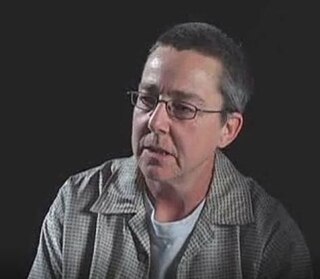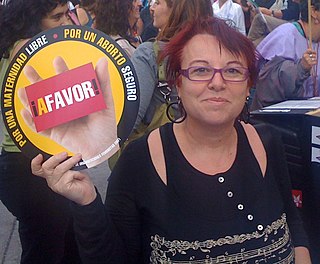
Shulamith Bath Shmuel Ben Ari Firestone was a Canadian-American radical feminist writer and activist. Firestone was a central figure in the early development of radical feminism and second-wave feminism and a founding member of three radical-feminist groups: New York Radical Women, Redstockings, and New York Radical Feminists. Within these radical movements, Firestone became known as "the firebrand" and "the fireball" for the fervor and passion she expressed towards the cause. Firestone participated in activism such as speaking out at The National Conference for New Politics in Chicago. Also while a member of various feminist groups she participated in actions including picketing a Miss America Contest, organizing a mock funeral for womanhood known as "The Burial of Traditional Womanhood", protesting sexual harassment at Madison Square Garden, organizing abortion speak outs, and disrupting abortion legislation meetings.
Cyberfeminism is a feminist approach which foregrounds the relationship between cyberspace, the Internet, and technology. It can be used to refer to a philosophy, methodology or community. The term was coined in the early 1990s to describe the work of feminists interested in theorizing, critiquing, exploring and re-making the Internet, cyberspace and new-media technologies in general. The foundational catalyst for the formation of cyberfeminist thought is attributed to Donna Haraway's "A Cyborg Manifesto", third wave feminism, post-structuralist feminism, riot grrrl culture and the feminist critique of the alleged erasure of women within discussions of technology.
Faith Wilding is a Paraguayan American multidisciplinary artist - which includes but is not limited to: watercolor, performance art, writing, crocheting, knitting, weaving, and digital art. She is also an author, educator, and activist widely known for her contribution to the progressive development of feminist art. She also fights for ecofeminism, genetics, cyberfeminism, and reproductive rights. Wilding is Professor Emerita of performance art at the School of the Art Institute of Chicago.

Feminist art is a category of art associated with the late 1960s and 1970s feminist movement. Feminist art highlights the societal and political differences women experience in their lives. The hopeful gain from this form of art is to bring a positive and understanding change to the world, in hope to lead to equality or liberation. Media used range from traditional art forms such as painting to more unorthodox methods such as performance art, conceptual art, body art, craftivism, video, film, and fiber art. Feminist art has served as an innovative driving force towards expanding the definition of art through the incorporation of new media and a new perspective.
VNS Matrix was an artist collective founded in Adelaide, Australia, in 1991, by Josephine Starrs, Julianne Pierce, Francesca da Rimini and Virginia Barratt. Their work included installations, events, and posters distributed through the Internet, magazines, and billboards. Taking their point of departure in a sexualised and socially provocative relationship between women and technology the works subversively questioned discourses of domination and control in the expanding cyber space. They are credited as being amongst the first artists to use the term cyberfeminism to describe their practice.
subRosa is a cyberfeminist organization led by artists Faith Wilding and Hyla Willis.
Feminist Digital Humanities is a more recent development in the field of Digital Humanities, a project incorporating digital and computational methods as part of its research methodology. Feminist Digital Humanities has risen partly because of recent criticism of the propensity of Digital Humanities to further patriarchal or hegemonic discourses in the Academy. Women are rapidly dominating social media in order to educate people about feminist growth and contributions. Research proves the rapid growth of Feminist Digital Humanities started during the post-feminism era around from the 1980s to 1990s. Such feminists’ works provides examples through the text technology, social conditions of literature and rhetorical analysis. Feminist Digital Humanities is aimed to identify and explore women's sense of writing as well as to prove widespread of women's work in most of the digital archive.
The feminist art movement refers to the efforts and accomplishments of feminists internationally to produce art that reflects women's lives and experiences, as well as to change the foundation for the production and perception of contemporary art. It also sought to bring more visibility to women within art history and art practice. By the way it is expressed to visualize the inner thoughts and objectives of the feminist movement to show to everyone and give meaning in the art. It helps construct the role to those who continue to undermine the mainstream narrative of the art world. Corresponding with general developments within feminism, and often including such self-organizing tactics as the consciousness-raising group, the movement began in the 1960s and flourished throughout the 1970s as an outgrowth of the so-called second wave of feminism. It has been called "the most influential international movement of any during the postwar period."
Susanna Paasonen is a Finnish feminist scholar. She is a Professor of Media Studies at the University of Turku, and was a visiting scholar at MIT in 2016. She gained her PhD from the University of Turku in 2002; her dissertation was on gender and the popularization of the internet, which was later published through Peter Lang. After holding positions at the universities of Tampere, Jyväskylä and Helsinki, Paasonen was appointed Professor of Media Studies at the University of Turku on 1 August 2011, and publishes on internet research, media theory, sexuality, pornography and affect.
Linda Dement is an Australian multidisciplinary artist, working in the fields of digital arts, photography, film, and writing non-fiction. Dement is largely known for her exploration of the creative possibilities of emergent technologies such as the CD-ROM, 3-D modelling, interactive software, and early computing.
Julianne Pierce is an Australian new media artist, curator, art critic, writer, and arts administrator. She was a member of the groundbreaking group VNS Matrix. She went on to become a founding member of the Old Boys Network, another important cyberfeminist organisation. She has served as executive director of the Australian Dance Theatre and is Chair of the Emerging and Experimental Arts Strategy Panel for the Australia Council. Pierce was executive director of the Australian Network for Art and Technology (ANAT) from 2000 to 2005, based in Adelaide, and was Executive Producer of Blast Theory from 2007 to 2012, based in Brighton in the UK.
Katy Deepwell is a feminist art critic and academic, based in London. She is the founder and editor of n.paradoxa: international feminist art journal, published 1998-2017, in 40 volumes by KT press. She founded KT press as a feminist not-for-profit publishing company to publish the journal and books on feminist art. KT press has published 8 e-books, supported by the Andy Warhol Foundation for the Visual Arts. In Feb 2017, Katy Deepwell wrote and published a MOOC on feminism and contemporary art at. In May 2020, a second advanced course on feminist art manifestos was added to the site. The model for both MOOCs is FemTechNet’s DOCC: Distributed Open Collaborative Course.
Radhika Gajjala is a communications and a cultural studies professor, who has been named a Fulbright scholar twice.

Nancy Evelyn Paterson (1957–2018) was a Canadian artist and writer known for her work in new media. She was an associate professor at the Ontario College of Art and Design University from 1990 to 2018, and was Facilities Coordinator at Charles Street Video, a non-profit, artist-run centre providing production and post-production facilities for digital video and audio.

Jennifer Radloff is a South African feminist activist and a pioneer on Information and communications technology (ICT) for social justice. She works for the Association for Progressive Communications (APC) in the Women's Rights Programme and is a board member of Women's Net.

Nathalie Magnan was a media theoretician and activist, a cyber-feminist, and a film director. She taught at both universities and art schools, and is known for initiating projects linking Internet activism and sailing with the Sailing for Geeks project. She also co-organised the Los Angeles Gay and Lesbian Film Festival in 1984. She died at home of breast cancer.

Montserrat Boix Piqué is a Spanish journalist, considered among the most influential women in her country. In early 2000, she created and developed the concepts of social cyberfeminism, and a year later those of feminist hacktivism. Another of her main areas of work is gender violence and communication. She has also stood out as a defender of the right to communication and citizenship rights for women. Since 1986, she has been a journalist for the Information Services of Televisión Española (TVE), in the international section.
Faces is an international online community of women who share an interest in digital media arts. They communicate via an email list and organize events both online and off. Founded in 1997, this informal network includes activists, artists, critics, theoreticians, technicians, journalists, researchers, programmers, networkers, web designers, and educators.
Prema Murthy is an American, multi-disciplinary artist based in New York. Employing aesthetics, gesture, geometry and algorithmic processes, Murthy's work explores the boundaries between embodiment and abstraction, while engaging in issues of culture and politics. Her work has been exhibited nationally and internationally at MoMA PS1, the Whitney Museum of American Art, the New Museum of Contemporary Art, the Reina Sofia Museum, the Generali Foundation in Vienna, and the India Habitat Center-New Delhi.
The Old Boys Network was the first international Cyberfeminist alliance. It was founded in 1997 in Berlin and remained active until 2001.
Paasonen, Susanna. “Revisiting cyberfeminism.” Communications 36 (2011): 335-352. Wilding, Faith and Critical Art Ensemble. “Notes on the Political Condition of Cyberfeminism.” Art Journal 57, no. 2 (1998): 47-60. Sollfrank, Cornelia. “Female Extension.” (September 2010): 1-9. Sollfrank, Cornelia. “Have script, will destroy! Interview of the hacker Clara G. Sopht.” (February 2000). Sollfrank, Cornelia. “Women Hackers.” Next Cyberfeminist International (March 1999): 1-10.






